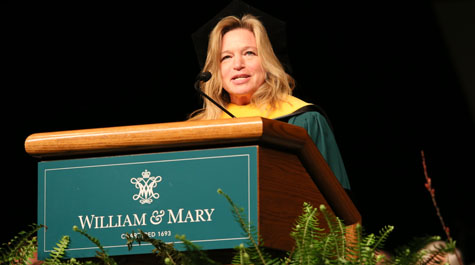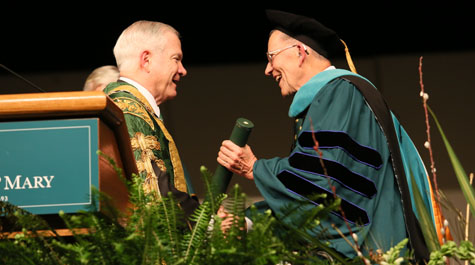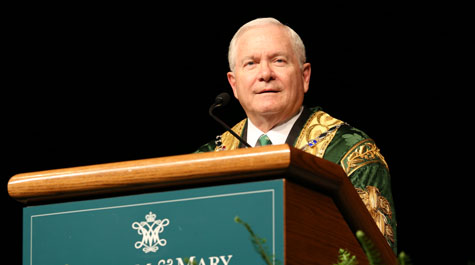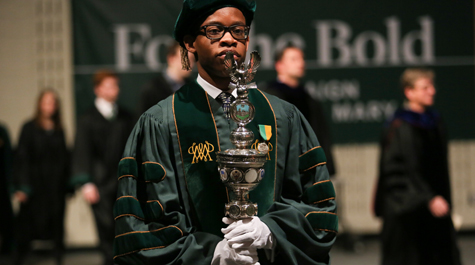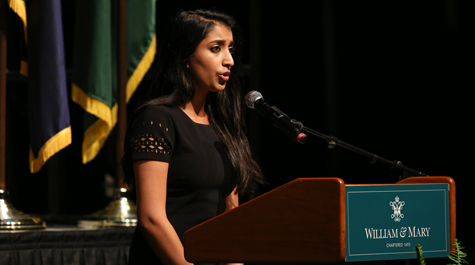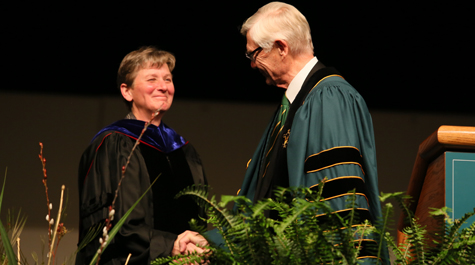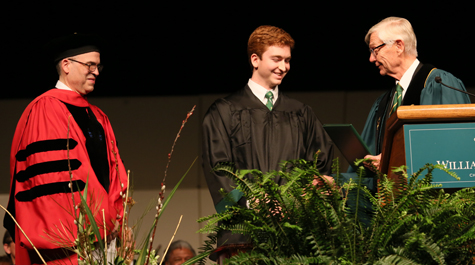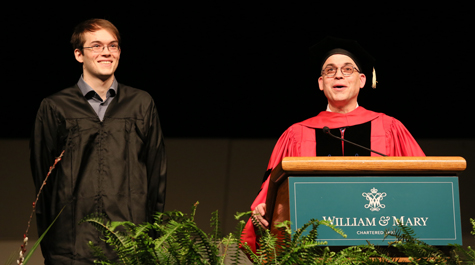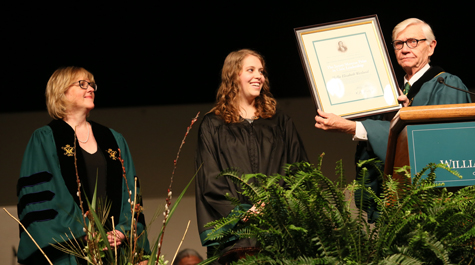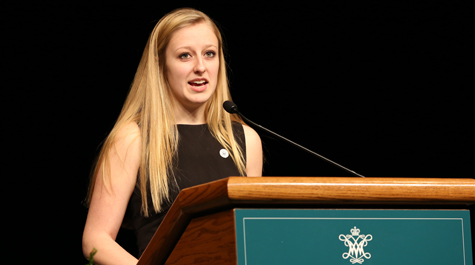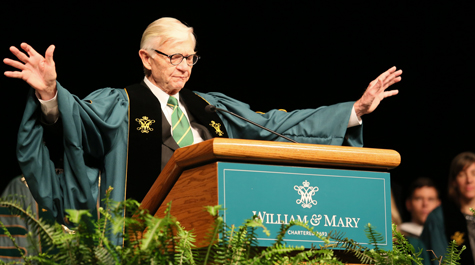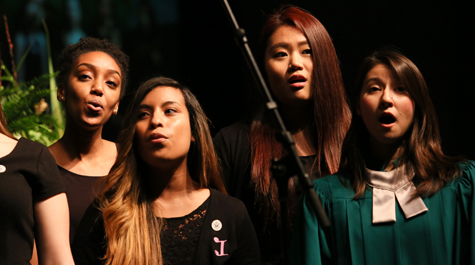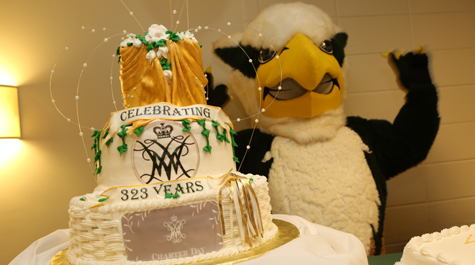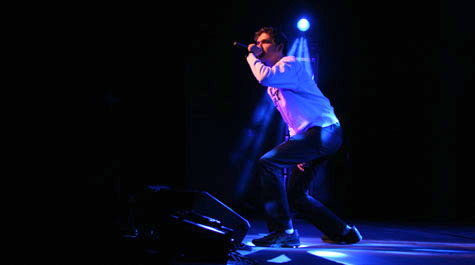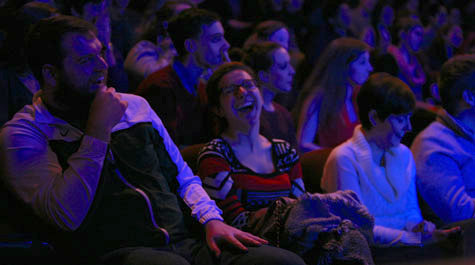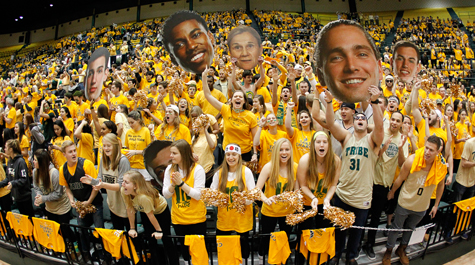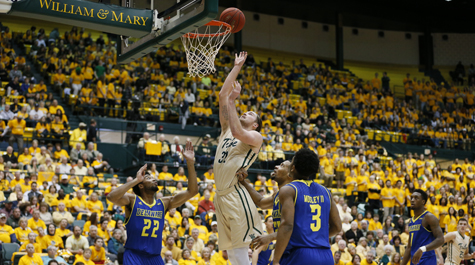Ellen Stofan '83: Contributions of all needed as NASA reaches for Mars
The work that NASA does in space can help address some of the most pressing challenges facing Earth today, NASA Chief Scientist Ellen Stofan ’83 told a crowd of thousands in William & Mary Hall Friday. And science needs the talents and contributions of a diverse group of people to help tackle those issues.
“NASA isn’t just about space exploration and humans on Mars,” she said. “We’re about making life better here at home through endeavoring to do great and challenging things.”
Stofan served as the keynote speaker at William & Mary’s 2016 Charter Day ceremony, an event that celebrated the university’s 323nd “birthday” – the day on which it was founded by royal charter in 1693. In addition to speaking at the event, Stofan received an honorary degree along with Professor of Government Emeritus Jack Edwards. W&M Chancellor and former U.S. Secretary of Defense Robert M. Gates ’65 also participated in the celebration, saying that Charter Day marks a time when two monarchs united with colonists around the belief that higher education could do “great good in the New World.”
“A unified belief still guides this university today, that a William & Mary education, one grounded in the liberal arts, will do great good in a constantly changing world. William & Mary has been and still is a place ‘for the bold,’” Gates said, referencing the title of William & Mary’s recently launched campaign.
Gates also voiced his support for scholarships, which is a focus of the campaign and which allowed him, as a first-generation college student from Kansas, to attend William & Mary.
“Scholarships put a William & Mary education within reach for generations of bold students yet to come,” he said. “Each of us should consider how we might make a difference at William & Mary through scholarships.”
From W&M to Mars
Stofan – who shares her alma mater with her husband, two children and a nephew (who’s a current student) – said that William & Mary nurtured her love of learning and will be part of the fabric of her life for “all time coming,” quoting from the university’s charter.
{{youtube:medium:left|EzyeQzjaUho, Stofan's keynote speech}}
William & Mary students today are part of the “Mars Generation,” which could see the first manned mission to the Red Planet, Stofan said.
“This isn’t just the subject of science fiction,” she said. “It’s real, and NASA is on it. Just last fall we announced evidence of liquid water on the surface of present-day Mars. In our lifetimes, NASA and its partners hope to answer some of our most fundamental questions about life beyond Earth.”
But NASA isn’t just about space exploration; the agency uses what it learns from other planets to help understand some of the most significant challenges facing Earth today, including climate change, she said. NASA research has also been used in such terrestrial applications as GPS technology, drones, anti-icing systems, artificial limbs, software and food safety.
“By going to the moon, working every day on the International Space Station, moving humans towards Mars, we improve life here on Earth,” said Stofan, who studied geology at W&M.
In order for NASA and other science organizations to meet the challenges of today and tomorrow, diversity is needed in science classrooms and labs, “because science is for everyone, because we need all the brainpower we can get, because relying on less than all of your population is no way to get anything done,” Stofan said.
“And it’s not just about diversity; it’s about inclusion,” she added. “It’s not enough to open the door. It is about ensuring that those who come through it feel welcome and safe. We have a responsibility as a society to ensure that everyone – regardless of their gender, skin color, sexual preference or economic status – has the opportunity to contribute and that everyone’s potential is realized.”
Referencing the life of Katherine Johnson, an African-American scientist, mathematician and recent Medal of Freedom recipient, Stofan told the students that they will likely encounter naysayers in their lives, telling them don’t belong or aren’t welcome, but they do belong and have much to contribute.
“Together – as a Tribe – we can do anything,” she said. “William & Mary is giving you the foundation to contribute so much and is making sure you have that opportunity.
“… Whether it’s cracking open rocks in the geology department here at William & Mary, falling in love with numbers or serving in whatever directions your passions take you, find your calling and pursue it with everything you’ve got. Remember to thank those who cheered you on along the way. Then come full circle in your life by giving back. That way the cycle will go on, in ‘all time coming.’”
Awards and reflections
Several members of the William & Mary community received awards during the ceremony. Leisa Meyer, professor of history, American studies and gender, sexuality and women's studies, received the Thomas Jefferson Award, and Jeremy Pope, assistant professor of history, was recognized with the Thomas Jefferson Teaching Award. Each gave brief remarks, with Pope thanking three teachers – all of whom were in attendance – who had inspired him.
{{youtube:medium:left|20KR1sLpsDQ, Pope's Charter Day remarks}}
Meyer discussed the changes related to LGBTQ rights and other social justice issues she has seen within the state and nation since joining the W&M faculty more than 20 years ago, and she voiced her hope that progress would continue.
“It is my privilege to accept and hope that this new year will indeed move us past the crux of change to its realization,” Meyer said.
{{youtube:medium:left|YPyuDVGQxwU, Meyer's Charter Day remarks}}
Two students were honored with the Jefferson Prize in Natural Philosophy: Isaac Alty ’16 and Andrew Halleran ’16. Additionally, Hallie Westlund was honored for her service work with the Monroe Prize for Civic Leadership.
The recipients of this year's Alumni Medallions were also recognized: Ann Harvey Yonkers ’63, Walter W. Stout ’64, Jane Thompson Kaplan ’56 and Glenne Hines Harding ’65.
{{youtube:medium:left|cfyT6ZdZ8uk, The Intonations perform}}
Multiple members of the campus community read from the charter during the ceremony, and Emily Nye ’16 offered her reflections on the document that began W&M’s story.
“There is something about William & Mary that inspires people to not only lead great lives, but to tell great stories,” she said. “People come here to this historic school, each with their own tale, and together the thousands of Tribe voices weave together to form one incredibly powerful and unique narrative.”
As President Taylor Reveley brought the ceremony to a close, he said that “a great university is just beginning to get into gear at 323,” especially if that university has been tempered by such challenges as war and privation.
Throughout such challenges, he said, “William & Mary has proven to be more than durable and long-lived; it’s proved to be nigh on to indestructible and capable of rising to new heights."
{{youtube:medium:left|uTRvn8Zk5k8, Reveley's closing remarks}}
“This university really is a phoenix. It is one tough bird,” Reveley said. “And I believe that students now at the College will see their alma mater rise to truly extraordinary heights in their century, the 21st century, and one reason this university will rise to those heights is the support, the love and the respect that it’s graduates will give it.
“So I really believe that William & Mary, born on February the 8th, 1693, is just beginning to roll.”














